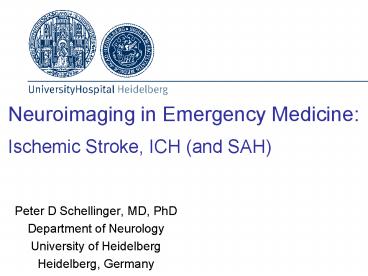Neuroimaging in Emergency Medicine: Ischemic Stroke, ICH (and SAH) PowerPoint PPT Presentation
1 / 42
Title: Neuroimaging in Emergency Medicine: Ischemic Stroke, ICH (and SAH)
1
Neuroimaging in Emergency MedicineIschemic
Stroke, ICH (and SAH)
- Peter D Schellinger, MD, PhD
- Department of Neurology
- University of Heidelberg
- Heidelberg, Germany
2
Stroke
- Incidence 150-250 / 100.000
- Prevalence 800 / 100.000
- 3rd most common cause of death
- Leading cause of dependence
- Most expensive disease overall
3
ICH is a common subtype of Stroke
- Increasing incidence
- 1030 of all strokes
- In the USA, 45,000 new cases of ICH/year
- Age gt55 years old
- Sex malesgtfemales
- Geographic variation
- Overall, 1020 per 100,000
- Afro-Americans and Japanese, 50 per 100,000
4
Also ICH but not in this talk
SDH (Subdural Hemorrhage) EDH (Epidural
Hemorrhage) ICH (Intracerebral Hemorrhage)
5
Two types of stroke -Same symptoms
- Occlusion
- Ischemic stroke
- (? 80)
Bleeding Intracerebral haemorrhage (?15)
6
Two types of strokes -Diagnosed with imaging only
- Occlusion
Bleeding
7
Two types of stroke -Different treatments
- Occlusion
Bleeding
Factor VII
Therapy Dissolve the clot Thrombolysis
Therapy Currently none - but
rt-PA
8
Causes of SAH
- Aneurysm 70-75
- Angioma 10
- Arteriosclerosis 5-10
- Spinal Angioma 2-5
- Others 5
9
SAHClinical presentation and Imaging
- Clinical presentation different from ICH and IS
- Only similar when either
- Secondary or concomitant ICH
- Subacute Vasospasm with stroke
- (CT-)Angiography
- Lumbar puncture
- Surgery vs intervention
10
Ischemic Stroke
11
Patients favorable outcome (modified Rankin 1)s
rt-PA Placebo p
3 mo 43 27 lt .001
6 mo 41 29 .001
12 mo 41 28 .001
12
Global Outcome (mRS 0-1, Barthel Index 95-100,
NIHSS 0-1) Day 90 Adjusted Odds Ratio with 95
Confidence Interval N 2799
Metaanalysis NINDS, ECASS III, ATLANTIS
Adjustierte Odds Ratio
Time Interval (OTT) min
Lancet 2004, 363 768-774
13
(No Transcript)
14
The hyperdense MCA sign
- 40-60 in angiographically proven occlusion
- 17 in unselected stroke patients
15
The hyperdense MCA sign
16
Sulcal Effacement
- Sulcal Effacement due to focal swelling
- Loss of grey/white differentiation
17
Loss of the Insular Ribbon and Basal Ganglia
Hypoattenuation
- Obscuration of the right basal ganglia
(arrowheads) - Loss of demarcation of the insular cortex
18
Early Infarct Signs and follow up
19
Early Signs of a large infarction (gt 1/3 MCA sign)
20
(No Transcript)
21
CT-Criteria ASPECTS
Normal 10 Pt
Cutoff 7 Pt
Complete MCA Infarction 0 Pt
Barber PA, Demchuk AM, Zhang J, Buchan AM.
Validity and reliability of a quantitative
computed tomography score in predicting outcome
of hyperacute stroke before thrombolytic therapy.
Aspects study group. Alberta stroke programme
early ct score. Lancet. 20003551670-1674.
22
Early CT Signs Reading Tea Leaves
Sensitivity NINDS, ECASS I and II on site at
randomization 30-45
23
NINDSAre Early CT signs relevant?
- Analysis of all baseline CTs 616/624 NINDS
patients - Incidence of Early CT Signs 31
- Significant Association Initial NIHSS Time
Window - No Association Outcome, Infarkt size, sICH Rate
- Conclusion Early CT signs do not influence the
effect of rt-PA (within 3h time window !!!) - Problem One-Third-MCA-territory criterion not
tested
Patel et al, JAMA 2001
24
Large or old infarction ??
3h?
25
Hemorrhage or Ischemia ??
This is the question ??
26
CT more or less normal or not ?
27
CT more or less normal or not ?
Ø treat
Ø treat
Ø treat
Treat with rt-PA lt3h!!
28
Intracerebral Hemorrhage
29
Diagnosis
- There is no way to differentiate ICH from
ischemic stroke by clinical means only - Loss of consciousness ? DD posterior
circulation - Headache ? DD Migraine
- Vomiting ? DD Cerebellar Stroke
30
Primary ICH - etiology
31
Primary ICH (gt80)
- Hypertension (RRR of 50 when treated)
- Amyloid (kongophilic) Angiopathy
- Microaneurysms, Leucoaraiosis
- Alcohol abuse
- No obvious underlying pathology
Correct Imaging Based Classification by Experts
in only 66.8
32
Diagnostic Standard for ICH CT
33
Subtypes by localization
A
C
Lobar 3452
D
E
B
Deep 3048
Infratentorial, Cerebellar 915
Qureshi et al. N Engl J Med 2001
34
Imaging signs of poor prognosis
35
Differential Diagnosis
Primary Lymphoma
36
ComplicationsEarly increase in ICH volume
CT control Brott 1997 n 103 Prosp. () Fujii 1994 n 419 Retrosp. () Flibotte 2004 n 35 Retrosp. () Kazui 1996 n 204 Retrosp. ()
03 h 26 18 54 36
36 h NA 8 NA 16
06 h NA 17 NA 52
324 h 12 2 NA 10
Increase in ICH volume and re-bleeding is
associated with clinical deterioration
Warfarin
37
Sequential CT StudiesEarly Growth / Rebleeding
- This CCT confirms the most likely cause of early
clinical deterioration in patients with acute
ICH - Re-bleeding
- Intraventricular blood (IVH)
95 min after SO
3 h after SO
38
Elevated ICP Glioblastoma multiforme
39
Elevated ICPICH Maximum Damage
40
ComplicationsCSF Circulation Blockade
41
External Ventricular Drainage (EVD)
42
Effects / Complications of ICH
- Primary
- Growth
- ICP elevation
- Secondary
- Oedema
- Intraventricular extension
- Hydrocephalus
- Seizure

